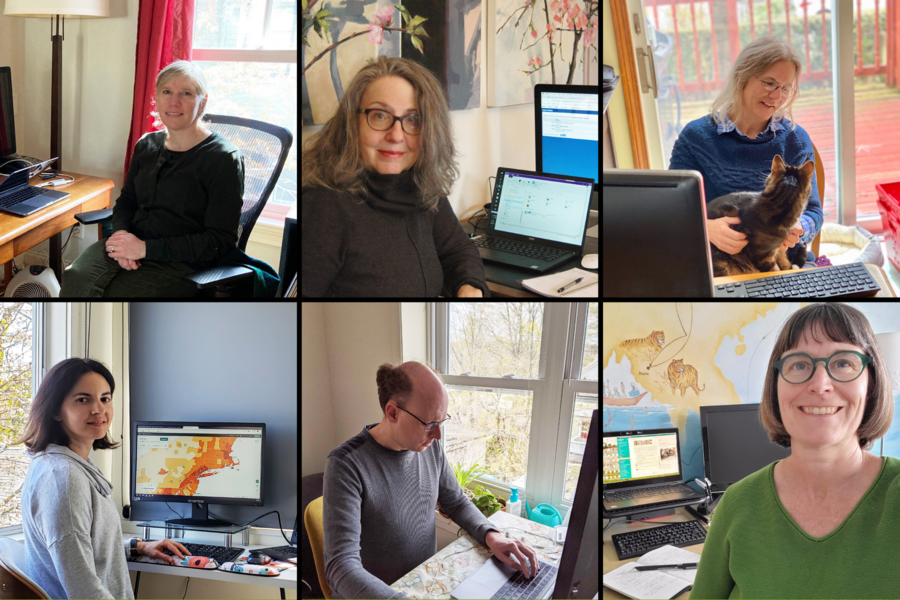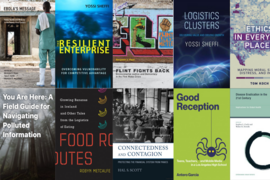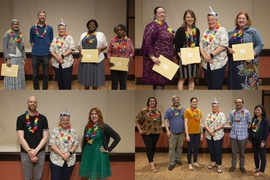While the MIT Libraries’ physical spaces and tangible collections are currently inaccessible, its network of people, services, and resources has mobilized behind the scenes to ensure that Institute learning and research continue despite the disruptions of Covid-19.
Since mid-March, the MIT Libraries have provided only services and resources that can be accessed remotely. Library staff — like many across MIT — had to quickly pivot to a new reality, finding creative solutions to providing the expertise and resources the community needs now.
Expanding access to digital content
Without access to physical collections, library staff have had to navigate a complex landscape of publishers, platforms, and copyright to access the materials MIT students, faculty, and researchers depend on.
Once physical library locations closed, staff sprang into action to identify alternative resources to print and fulfill requests from the MIT community and beyond:
-
Staff have loaded more than 300,000 new e-books and added 475,000 links to digital versions of materials in the catalog through the HathiTrust Digital Library.
-
The “Covid Collections Group” created a guide to dozens of free and expanded resources for textbooks, e-books, journals, film, and music through offers from publishers during Covid-19.
-
1.4 million titles are available through the Internet Archive’s National Emergency Library.
-
Staff expedited 150 purchases of materials requested by the MIT community, including technical standards related to face mask manufacturing.
-
Article requests, which have seen a 33 percent increase during the closure, have been filled at a rate of 88 percent, with an average turnaround time of nine hours.
-
Staff fulfilled 90 percent of lending requests despite the difficult circumstances, with less than a half-day turnaround, on average.
The rapid move to remote work has required a nimble, creative response from library staff, but the benefits of pivoting to a digital-first model could last far beyond Covid-19.
“Providing comprehensive digital access to content has been a foundational part of our vision for the future of research libraries,” says Chris Bourg, director of the MIT Libraries. “But I think our current crisis, where we’ve been forced to quickly adapt to a remote environment, has really thrown into relief how important it is. Research and learning depend on more open and equitable access to knowledge, and that will be true long after this crisis passes.”
Here to help, wherever you are
Some library services have had to adjust to provide more flexibility: recognizing that plans change and time zones and working hours vary, the libraries increased the hours the AskUs chat service is available, and extended the length of time interlibrary borrowing requests can be downloaded. Others have adapted easily — such as providing expertise in a specific subject area, data management, or copyright — with the help of a few new tools.
Daniel Sheehan, program head for GIS and Statistical Software Services, describes a recent morning’s work: “I got a couple of economics grad students — one in France — together with a political science grad student to talk over Zoom about redistricting software while getting real-time help from a colleague over Slack. An undergrad needed help accessing the mapping software Arcgis Pro remotely on one of our GIS and Data Lab computers, so I got her going with screen sharing. Then I looked at data via Dropbox from an EAPS grad student in advance of a Zoom meeting he requested. It’s not the same as being on campus in person, but the technology seems to be working well in this strange time.”
All in it together: Support across the community
Beyond one-on-one help, library departments are finding ways to adapt to current needs, often requiring collaborations between teams or across the Institute. The libraries are gearing up for MIT-wide electronic thesis submission this spring. After running a successful e-thesis pilot with several departments, labs, and centers last year, library staff will take an existing tool developed for digital archives transfers and test to ensure it’s ready for widespread production to support the graduating class of 2020.
Distinctive Collections, meanwhile, is working with several classes, including Debbie Douglas’s History of MIT, to find ways of incorporating documentary efforts into assignments, so students take an active role in archiving our current experience. Staff are also web-archiving MIT websites and working to collect experiences across the Institute during this unprecedented time.
Finding opportunity amid the crisis, staff have found ways to streamline processes, call on diverse experts to problem-solve jointly, and employ their sophisticated understanding of the online information landscape to help MIT users. Looking to the future, they could brainstorm with faculty on new ways to bring library expertise into remote courses.
“At the libraries, our vision is for a more open, equitable, and interactive information ecosystem,” says Karrie Peterson, head of Liaison, Instruction, and Reference Services. “Librarians — online and asynchronously — are still working toward that vision, whether helping researchers with data-sharing practices or assisting student teams in exploring sustainability issues in their literature reviews. The current situation has highlighted the importance of open and equitable knowledge sharing and provides us with an extraordinary opportunity to move in that direction.”









